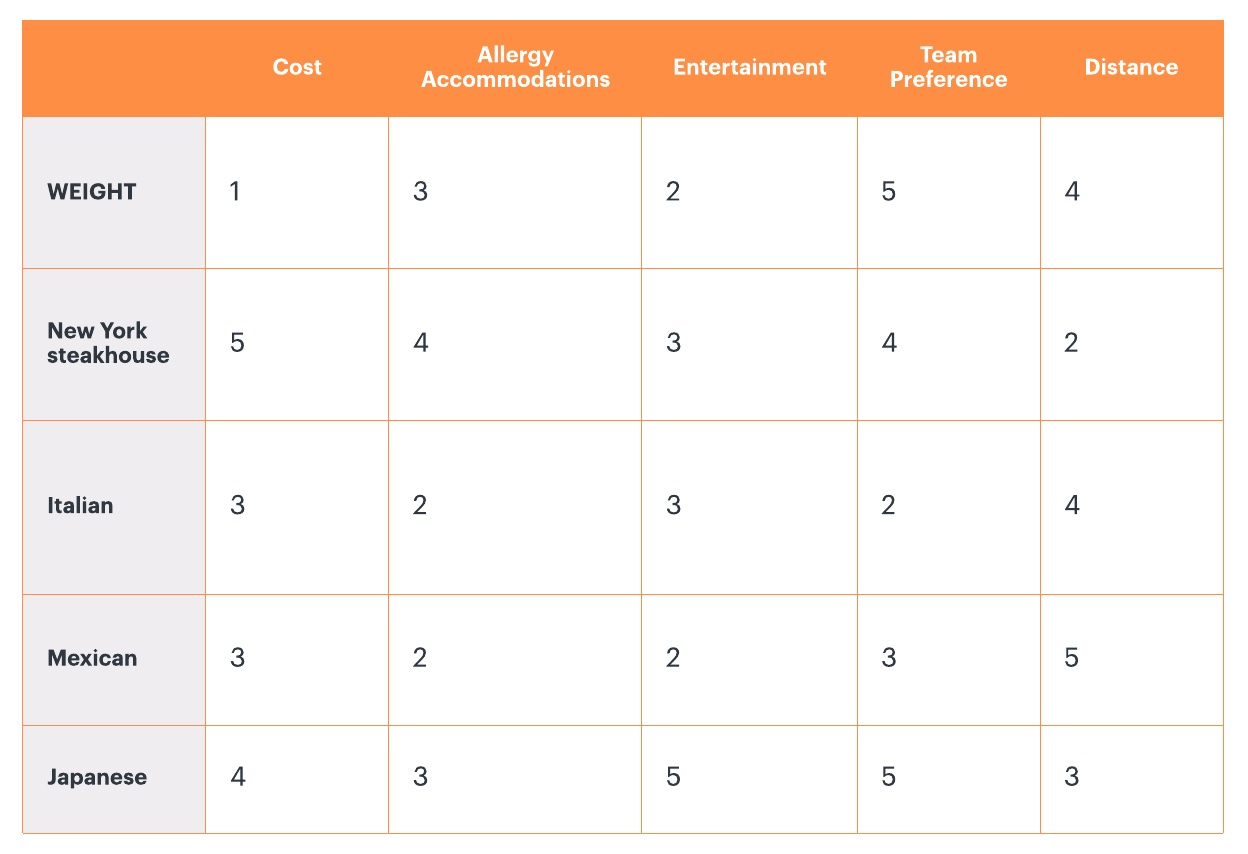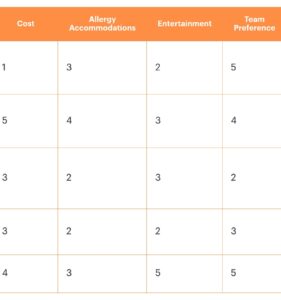Introduction
Making decisions can often feel like navigating through a maze blindfolded. Whether it’s deciding on a career move, selecting a vendor for your business, or choosing the best vacation destination, the stakes can be high, and the options overwhelming. In such situations, a decision-making matrix emerges as a beacon of clarity amidst the chaos. This article delves into the why and how of using a decision-making matrix to make informed choices.
Why Do We Struggle to Make Choices?
Decision-making is a fundamental aspect of human life, influencing every aspect from the mundane to the monumental. Yet, despite its ubiquity, many individuals find themselves grappling with indecision and uncertainty when faced with choices. Understanding why we struggle to make decisions can shed light on the complexities of human cognition and behavior.
Cognitive Overload
One of the primary reasons for decision paralysis is cognitive overload. In today’s information age, we are bombarded with an abundance of choices, ranging from what to eat for breakfast to which career path to pursue. The sheer volume of options can overwhelm our cognitive faculties, making it challenging to process information and arrive at a decision. This cognitive overload can lead to decision fatigue, where individuals become mentally exhausted from weighing multiple alternatives, ultimately leading to procrastination or avoidance of decision-making altogether.
Fear of Making Mistakes
Fear of making mistakes is another potent deterrent to decision-making. The prospect of choosing the wrong option and facing adverse consequences can induce anxiety and apprehension, prompting individuals to postpone decisions indefinitely. This fear of failure is often rooted in a desire to avoid regret or embarrassment, leading to a preference for maintaining the status quo rather than taking risks or making changes.
Perfectionism
Perfectionism can also hinder decision-making by setting impossibly high standards for the optimal outcome. Individuals who adhere to rigid standards of perfection may agonize over every detail, striving for an unattainable level of excellence. This perfectionistic mindset can breed indecision, as individuals become fixated on finding the flawless solution rather than accepting the inherent imperfections of any choice.
Limited Information and Analysis Paralysis
In some cases, the lack of sufficient information or analysis can impede decision-making. When faced with complex or ambiguous situations, individuals may feel ill-equipped to assess all relevant factors and predict the potential outcomes accurately. This uncertainty can lead to analysis paralysis, where individuals become trapped in a cycle of overthinking and second-guessing, unable to make a definitive choice.
Conflicting Priorities and Values
Conflicting priorities and values can create internal conflicts that hinder decision-making. When individuals are torn between competing goals or principles, they may struggle to reconcile their conflicting desires and preferences. This inner turmoil can manifest as indecision or procrastination, as individuals grapple with the trade-offs inherent in each option and fear making choices that compromise their core beliefs or aspirations.
External Pressures and Expectations
External pressures and expectations from society, peers, or authority figures can also influence decision-making processes. The desire to meet external standards or fulfill others’ expectations can cloud individuals’ judgment and lead to decisions that prioritize external validation over personal fulfillment or authenticity. This external influence can exacerbate feelings of uncertainty and self-doubt, making it challenging to assert one’s own agency and autonomy in decision-making.
Understanding the Decision-Making Matrix
A decision-making matrix, also known as a criteria matrix or grid analysis, is a systematic tool designed to help individuals or teams evaluate multiple options against a set of criteria or factors. It provides a structured approach to decision-making by quantifying and comparing different alternatives based on predefined parameters.
Importance of Structured Decision Making
In a orld inundated with choices, having a structured approach to decision-making is paramount. Without a systematic method, decision-makers risk succumbing to biases, overlooking critical factors, or making impulsive choices that may lead to undesirable outcomes. The decision-making matrix offers a systematic framework to mitigate these risks and enhance decision quality.
Why Use a Decision Making Matrix?
1. Clarity Amidst Complexity
The human mind has its limitations when it comes to processing vast amounts of information simultaneously. A decision-making matrix simplifies complexity by breaking down the decision-making process into manageable components. By clearly defining criteria and weighing them against each option, individuals gain clarity on the most favorable choice.
2. Objective Evaluation
Subjectivity often clouds judgment, leading to biased decisions. A decision-making matrix fosters objectivity by establishing clear criteria and assigning weights to each factor based on their relative importance. This quantitative approach minimizes the influence of personal biases, ensuring decisions are based on rational analysis rather than emotions.
3. Comprehensive Assessment
Every decision involves multiple dimensions, from cost and quality to time and risk. A decision-making matrix facilitates a holistic evaluation of alternatives by considering all relevant criteria simultaneously. This comprehensive assessment enables decision-makers to identify trade-offs and make well-informed choices that align with their goals and priorities.
4. Consensus Building
In collaborative decision-making scenarios, conflicting opinions and priorities among team members can impede progress. A decision-making matrix serves as a common framework for stakeholders to evaluate options objectively. By standardizing the evaluation process, it fosters consensus building and streamlines decision-making within groups or organizations.
5. Risk Management
Decisions inherently involve risks, ranging from financial implications to potential consequences on stakeholders. A decision-making matrix allows decision-makers to assess and mitigate risks systematically. By identifying potential pitfalls and evaluating risk factors alongside other criteria, individuals can make decisions that minimize exposure to adverse outcomes.
How to Create a Decision Making Matrix?
1. Define Decision Criteria
Begin by identifying the key criteria or factors that are relevant to the decision at hand. These criteria should encompass both quantitative and qualitative aspects that influence the decision-making process. For example, when choosing a supplier, criteria may include cost, quality, reliability, and customer service.
2. Assign Weight to Criteria
Not all criteria carry equal importance in decision-making. Assign weights to each criterion based on their relative significance. This weighting process allows decision-makers to prioritize factors according to their impact on the desired outcome. The sum of weights should equal 100%, reflecting the overall importance of criteria in the decision.
3. Evaluate Alternatives
List down the available alternatives or options that you are considering. For each alternative, assess its performance against each criterion and assign scores or ratings accordingly. This evaluation can be based on factual data, expert opinions, or past experiences, depending on the nature of the decision.
4. Calculate Scores
Multiply the scores of each alternative by the corresponding weights assigned to the criteria. Sum up these weighted scores for each alternative to obtain a total score. The alternative with the highest total score represents the optimal choice based on the predefined criteria.
5. Review and Iterate
Review the results of the decision-making matrix to ensure alignment with your objectives and preferences. If necessary, iterate on the criteria, weights, or alternatives to refine the decision-making process further. Solicit feedback from relevant stakeholders to validate the robustness of the decision and make adjustments as needed.
Decision-Making Matrix
In a world inundated with choices, making decisions can be daunting. However, by harnessing the power of a decision-making matrix, individuals and organizations can navigate complexity with confidence and clarity. By following a systematic approach to evaluate options against predefined criteria, decision-makers can make informed choices that align with their goals and priorities. Whether it’s selecting the best course of action in business or making personal life choices, the decision-making matrix serves as a valuable tool for optimizing decision quality and achieving desired outcomes.


